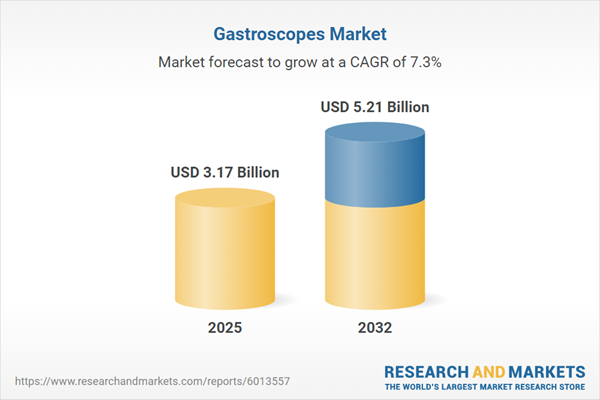Speak directly to the analyst to clarify any post sales queries you may have.
The gastroscopes market is evolving rapidly, shaped by technological advancements, shifting regulatory environments, and new clinical demands. Senior healthcare executives face increasing pressure to obtain up-to-date, targeted market insights to support informed, evidence-based procurement decisions and reinforce operational resilience.
Gastroscopes Market Snapshot: Market Size and Growth Outlook
The global gastroscopes market is valued at USD 2.96 billion in 2024, with projections of reaching USD 3.17 billion by 2025 and a potential expansion to USD 5.21 billion by 2032. Achieving a compound annual growth rate of 7.32%, this growth is primarily driven by widespread adoption of minimally invasive technologies, continuous innovation in gastroscope design, and solid investment from healthcare providers. As a result, gastroscopes are becoming indispensable tools in clinical environments, supporting effective, patient-centered care across hospitals, surgical centers, and outpatient clinics worldwide.
Scope & Segmentation in the Gastroscopes Market
Thorough segmentation analysis gives executive teams the perspective necessary for optimizing procurement and aligning capital investments with institutional objectives. The key segments forming the gastroscopes market each address essential strategic requirements and technology needs across healthcare organizations.
- Product Types: Flexible gastroscopes—including both fiberoptic and video models—and rigid alternatives cater to varying clinical applications. Availability of single-use and reusable devices addresses infection control protocols, cost-efficiency considerations, and the specific needs of diverse healthcare procedures.
- End Users: Large healthcare facilities, ambulatory surgical centers, and standalone clinical practices demonstrate distinctive patterns in procurement and preferences for integrating devices within their workflow. Understanding these differences supports tailored acquisition strategies and enhances operational fit.
- Applications: Gastroscopes are used for both diagnostic and interventional purposes, enabling providers to address a broad range of patient needs in both acute and outpatient settings, supporting seamless care delivery.
- Distribution Channels: Direct purchases, distributor partnerships, and digital procurement platforms all influence inventory management and reliability of device supply, allowing healthcare organizations to select models aligning best with their procedures and logistical priorities.
- Regional Coverage: Activity spans the Americas, Europe, Middle East & Africa, and Asia-Pacific. Market leaders benefit from detailed analysis of economies such as the United States, China, Germany, Japan, India, France, and Brazil—while local dynamics in Africa, the Middle East, and Southeast Asia provide unique strategic insights for regional planning and competitive positioning.
- Company Profiles: Leading manufacturers like Olympus Corporation, PENTAX Medical, Fujifilm Holdings, Ambu A/S, KARL STORZ, and Richard Wolf establish sector benchmarks, informing supplier selection and guiding long-term partnerships based on performance and innovation track record.
Key Takeaways for Gastroscopes Market Leaders
- Clinical imaging advancements and improved device interfaces are enhancing diagnostic precision and helping streamline care delivery processes in various clinical settings.
- The increasing shift towards single-use gastroscopes is transforming infection control strategies and driving development of new procurement frameworks and collaboration models across institutions.
- Integration of artificial intelligence and augmented reality is broadening gastroscope applications, facilitating advanced patient management, and strengthening clinical workflow capabilities.
- Ergonomic refinements and system designs focused on workflow optimization are increasing clinician efficiency and satisfaction, especially in procedural environments with high throughput requirements.
- Adaptive procurement strategies help organizations respond to regulatory changes faster, ensuring steady device access and resilience to shifting operational challenges.
- Greater collaboration among device manufacturers, digital health partners, and clinical stakeholders is accelerating innovation and supporting delivery of more unified healthcare experiences.
Tariff Impact: Navigating U.S. Trade Measures
Recent implementation of U.S. tariffs on imported gastroscope technologies has compelled procurement teams to reconsider sourcing strategies, encouraging more negotiations and deeper partnerships with domestic suppliers. Proactive management of cost, regulatory compliance, and logistics is essential to mitigate disruption and maintain a reliable supply of critical devices under evolving trade conditions.
Methodology & Data Sources
This report synthesizes feedback from gastroenterology clinicians, procurement managers, and technical experts. Rigorous validation comes from peer-reviewed academic research, relevant regulatory guidance, and trusted industry publications, delivering executive-ready, actionable market intelligence.
Why This Gastroscopes Market Report Matters
- Leaders receive evidence-based intelligence to streamline procurement and technology adoption for gastroscope solutions.
- In-depth trend monitoring and competitive analysis empowers organizations to manage risk and adjust clinical or operational strategies as the market evolves.
- Clear, targeted recommendations support compliance, enhance procurement efficiency, and inform strategic planning for senior leadership teams.
Conclusion
This report provides decision-makers with targeted intelligence to support procurement, technology integration, and opportunity identification throughout the changing gastroscopes market landscape.
Additional Product Information:
- Purchase of this report includes 1 year online access with quarterly updates.
- This report can be updated on request. Please contact our Customer Experience team using the Ask a Question widget on our website.
Table of Contents
3. Executive Summary
4. Market Overview
7. Cumulative Impact of Artificial Intelligence 2025
Companies Mentioned
The companies profiled in this Gastroscopes market report include:- Olympus Corporation
- PENTAX Medical Company
- Fujifilm Holdings Corporation
- Ambu A/S
- KARL STORZ SE & Co. KG
- Richard Wolf GmbH
Table Information
| Report Attribute | Details |
|---|---|
| No. of Pages | 182 |
| Published | October 2025 |
| Forecast Period | 2025 - 2032 |
| Estimated Market Value ( USD | $ 3.17 Billion |
| Forecasted Market Value ( USD | $ 5.21 Billion |
| Compound Annual Growth Rate | 7.3% |
| Regions Covered | Global |
| No. of Companies Mentioned | 7 |









